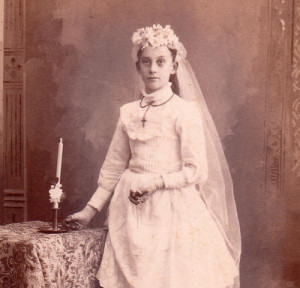 A photo has been circulating on the net, and in this photo — which is believed to be an example of Victorian Memorial photography — a young girl is shown standing next to a table dressed in a what appears to be a Confirmation dress with added rosary. Some people say the girl in this photo is dead and others say she isn’t. The truth is that she is indeed dead as her photo is very famous, albeit attached to much mystery.
A photo has been circulating on the net, and in this photo — which is believed to be an example of Victorian Memorial photography — a young girl is shown standing next to a table dressed in a what appears to be a Confirmation dress with added rosary. Some people say the girl in this photo is dead and others say she isn’t. The truth is that she is indeed dead as her photo is very famous, albeit attached to much mystery.
With that said, we bring you the tragic story about this young girl and why she looked the way she did.
It’s very rare to have an actual story about these old photos of the dead, so we are especially proud to bring you this story of Agnes Louise Farragat — a girl we only knew until recently as the “Dead Girl Standing” or “The Girl in the Confirmation Dress.” It also serves as a reminder to all of us to get a tetanus shot every now and then.
This is a Memorial Depiction (post mortem) of Agnes Louise Farragat , aged 17 (possibly 16), of Philadelphia, Pennsylvania USA, daughter of Eugene and Autumn (Charters) Farragat.
“Miss Farragat departed this earth April 13, 1884 after a sudden onset of fever of 4 days duration with dyspnea [breathlessness], palpitations, fretful disorientation with pallor and continuous spastic rigidity and painful arching of her of her back and spine, and thusly my diagnosis is acute tetanus with gangrenous complications of the right hand as a result of a splintered wood penetration to that hand. Noteworthy that there is no apparent lockjaw as one would expect.” [ Submitted Signature: Dr. Ferris Mills MD, Philadelphia].
Mortuary notes.
Agnes Farragat. Photographed in death by Collier Brothers Mortuary, Heston J. Collier proprietor , in his Philadelphia parlour 3 days and one afternoon after her passing from this life.
Miss Farragat was a skilled and capable reader, a singer of hymns and an accomplished student of violin and French language. She had given her hand in promise of marriage to Kelvin Morris Blake, 20, the son of the Arthur (deceased) and Hannah Blake of Camden, New Jersey and was to be married May 1, 1884 in a service of the Roman Catholic Faith to which she held so close to her heart as did her dear grandmother Lalique Charters of Albany, New York . And all this is very sad for both families and friends concerned. Young Mr. Blake is said to be inconsolable and had taken reluctantly to his bed on the orders of his physician, Dr. Drew Previtte MD who refused him access to his horse or any transportation until such time that he is in the company of his mother or a gentleman friend which was soon forthcoming in the form of many friends and family.
Later notes (1922) were added by her younger brother Thomas Farragat – (1873-1930)
“Our beloved Agnes so small and frail as she was in life with her hands and feet blackened as and her odor was foul. She was tightly wrapped in bolts of white linens which had been soaked in rosewater and glycerine to make her body less curved as it had been left at the moment of her death from spasms and she was swollen and festering about her abdomen. The large cherubic woman who did this wrapping was rather strong and stern and was without expression but she was kind in a matronly way and very determined and perhaps not wanting to attach herself to so much grief. I think she was a field nurse they said as she was very adept with linen bandages and the odor did not seen to disturb her in the slightest bit as it did Mister Collier and myself and the other men in his employ. A seamstress from town volunteered to remove the outer layer of her dress which was to also be her bridal gown so as to make it seem more demure and less celebratory and we were happy to have that done in the name of quiet dignity as Agnes had joined into ceremony with the Catholic Church as was the true faith of our beloved grandmother Lalique. I did not think it macabre at the time as our Agnes was not quite held aloft with a standing rack as I had seen being done in another time but rather she was very slightly inclined at the edge of the table which was made from heavy iron. Her right hand arm was very foul smelling just as it had already began to be while she was yet alive and in much distress, and Mister Collier was deeply disturbed by this as though she was his own child and he wept for a moment. He fastened flat iron to the back of her arms and spent much time adjusting and readjusting her stance. Her green eyes were flat and looking in no apparent direction yet they were held open and centered with spirit gum. However, with great distress to us all during the photography both eyes seemed to half close and wander but were later fixed artistically by a dedicated student who spoke in an accent which I could not identify. I remember too being so very sad for my sister, but Mister Collier was very kind and he took great pride in his work with devotion and sincerity which eased my anxieties. My mother refused to attend at this photography and my father stood outside for hours in the rain and did much pacing at the front of the mortuary and wanting only for this to end in spite of the fact that he had ordered this photograph to be a final tribute to be sent to his sisters in Virginia who were to have soon been enroute to the wedding at our home in Philadelphia. This was at a great expense to them as they were rather poor and increasingly depended on father for assistance. Immediately after this photograph was completed and Mister Collier was satisfied, my sister was placed in her coffin which was very pretty. Her coffin was closed with little ceremony and she was buried the next morning when thankfully the rain had stopped and her service was met with fine weather and the smell of springtime. Her beau was in attendance with his mother and sister and he openly wept without any discretion. I remember that we never were to see him again after the interment. I may miss a day in these events because I seem to recall a well attended church service but that may have all been on the same day. I was only 11 years old at the time.
Notes: A further investigation into this cause of death would most likely be tetanus poisoning as a result of an injury to her right hand by a heavy splinter from a hard wood pile that had penetrated the soft part of her palm and had caused her great pain and swelling for many days prior to her falling gravely ill. Agnes Farragat was supposedly buried in Philadelphia but her grave has not been located. It may have been excavated and reused in 1988 as per the rules of the cemetery which reuses graves after 99 years unless perpetual care is paid. It may not have been payed due to the fact that the Farragat family simply forgot or expected to remove her at the time of their own deaths or they were unaware. [Alistair Gerritson MD]
So yes, this is a real dead person. And now you know the story. Damien LeGallienne. More explanations and examples can be found if you contact this writer at this link. http://www.imdb.com/name/nm3834680/?ref_=fn_al_nm_1



How was the information regarding the girl in the confirmation dress attained? Did the author track this information down himself or hire a private eye? Also, what is the source of the original post-Mortem photograph?
I posted earlier about how you obtained the information on this post regarding the “Girl in the Confirmation Dress” without first reading the “About the Damien Zone” block.
I get that this website is meant for humor and satire, but how much of the above story is actually factual?
I was hoping to find out more about the young woman in the photograph.
This is not a post mortem image and this is NO way a 17 year old girl.
Its not older than 14 years old, regular age when girl did their confirmation (First communion). Its pretty evident to see.
I believe this girl died at age 17, but this image was taken WAY before her death.
She’s dead — go to the Philadelphia Hall of Records and see for yourself. The entire story is there for all the world to see — she was 16. Not all stories are satire here. We do indeed mention that human achievment is high on our list of subjects when we set out to do a story.
Here’ the thing. There is some discrepency about the girl’s age but only because she might thave been 16 and not 17. Some distant and not-so-distant members of her family in New Jersey and Pennsylania (USA) had, for some reason, converted from the Presbyterian faith to the Roman Catholic faith which had been the religion of her paternal grandmother who had been for years looked down upon as a French outcast in a family heavily wrought from fairly prominent English and Sottish stock.
Eugene Farragat, the father of the girl in this photo, was a progressive minded man, and he agreed that his, “daughter should follow her lord and saviour whichever way she chose” — ergo, she was going to be Confirmed in the Catholic Church.
She would normally have been confirmed at age 13 but her conversion happened later in life by her own choice until it closely coincided chronlogically with her upcoming marriage. With that in mind, a local seamstress named Elvera DeLuca was hired to make a dress which would serve as her Confirmation dress and, with added decoration, could be used as a wedding dress without too much finery or fuss in the process. It was even discussed that her comfirmation and her wedding be held during the same ceremony. Such a thing was not unheard of at the time and for centuries before in Europe when middle-aged Protestant or Jewish men married into the Catholic faith.
The Farragats were not rich but they were certainly not poor or average, and by the standards of their time, there was a certain degree of keeping up appearances. For all intents and purposes, the Farragats were fairly well off and somewhat society-adjacent. The actual wealthy social calendar class lived in another world unto themselves. You could not “buy into” Philadelphia society, but in later years, many people with new money did — and still do. The fact that Eugene was born of a Catholic mother was not so discretely snickered about, but he had risen above that with his thriving business as a lawyer and real estate ombudsman (financial planner).
The fact, however, that someone in the Farragat family would convert to Catholicism was fodder for gossip in their social circle, but Eugene rose above the “petty minded provincials” and threw all of that back in people’s faces by having his daughter memorialized in that dress. The Rosary beads she holds were an additional slap in the face at people who had criticized his daughter and who also had hurt him deeply as a child when his mother was maligned for her faith.
Another interesting point is that it did not go unnoticed when it was revelaed the deceased had injured her hand while fetching her own firewood. This was something she should never have done herself. This was the job of a servant or handyman, but the Farragat family had only one servant — a woman from Trinidad named Candace Foutier who tended mostly to cooking and caring for Eugene’s elderly father, Lyle Farragat who lived into his 90s.
Yes, there was a time when Roman Catholics in the USA were seen as low class servants of the Pope or “priest lovers” or “Mackeral smackers” because of their adherence to Catholic rituals such as not eating meat on Friday. They were seen as people who couldn’t think for themselves and their affiliation with the church of Rome associated them with poverty (Irish or South American) and with the French in the southern part of the USA who, even if they had wealth and property, were still viewed as low class trash.
Damien LeGallienne
Damien Direct Mail or DDM@thedamienzone.com
I don’t believe there is anyway for this to be Agnes Louise Farragat. I owned the original cabinet photograph that the crop posted above was taken from for over 10 years, until I sold it a few years ago. That photograph was taken in Muscatine, Iowa. So I don’t know see how it could possibly be someone from Philadelphia. She’s wearing a Catholic confirmation dress, not a wedding dress. It’s a cool story though.
~Kari
Kari — the photo and the story and other photos of this family can be found and inspected in Philadelphia. By the way, Karl, the sky is blue — now tell me what’s the truth about that in Muscatine, Iowa. Yes, Agnes is indeed wearing a confirmation dress which was made to double as a wedding gown two weeks hence with some added frill and finery. Read the story carefully. LOOK IT UP — do the legwork like my guys did. If I am wrong — which I am not — you have the only photo of a Roman Catholic in Iowa prior to 1918. Here is a letter I got from the Farragat family which owns the original.
“Dear M. LeGallienne.
Thank you for telling the full story of my great, great, great aunt and the details of the story are true as you have stated them and we thank you for your kindness and dedication in your investigation. I have additional photos that were taken and are a lesss acceptable and less pleasing to the eye, and also pictures taken by the physicians which were used in a University of Maryland medical text which was published in 1907 but I prefer not to share these in spite of the fact that the medical photos are available if one knows where to look. I have in my possesion, the original transcript from the doctors and my great great great uncle as well as a letter of thanks from the woman who dressed Agnes, and her was named Ione McFeer. She was 53 years old at the time and lived to be 102 years old and until she stopped working at age 90, this is the work she did. Thank you tremendously for sharing the truth.
Bonita Farragat-Menken
Maidenhead, England
Hey DMM,
What’s with the tone? I am NOT saying that your story is not factual or well researched. I loved reading the story and I appreciate all the info. I’m just not sure the photo posted above is Agnes. As a person who was fascinated by and owned this photograph for many years I would LOVE, LOVE, LOVE to know this girl’s true story. She still continues to haunt me although I sold the photograph a few years ago. I still have full scans of the portrait. If I was able to post a photo here I’d be happy to share the full scan which shows the information of the photographer’s studio printed on the cabinet board. I originally bought that photo as one of many in an album back in 2002. Most of the other portraits in the album also taken in Muscatine, Iowa. So you can understand how I would find it confusing. Do the Farragats have a history in Iowa? I’m sure that you, like me, have had to deal with your share of people with very strong opinions on post mortem/ memorial photography/history. So maybe that’s why the knee-jerk reaction? I don’t mean to disprove anything. I’m merely sharing with you what I know about the portrait and hoping to understand how my photo got connected to this story.
~Kari
I have other photographs of Catholic girls in their confirmation dresses from Muscatine, Iowa. (they came from the same album that “Agnes” did.)They are definitely pre-1918. Possibly even pre-1900s. I had no idea that was a rare find! I honestly don’t know much Catholic history. I guess I have the world’s only collection of early Roman Catholic Iowans! 🙂
Have you ever heard of a twin – my daughter sent me this picture as it was randomly posted on facebook – they look so much alike from this picture. I am glad I was able to find out more information.
I searched Ancestry, newspaper records, and the internet for any record of the people or circumstances mentioned in the “story”.
If you look carefully, you will see that everyone mentioned in the story, including the dead girl,” appears anywhere in census records, cemetery records, city directories, professional directories, old newspaper reports, or ads. You can actually put the pieces of the puzzle together through public records.
This was a very well written and well researched story.
Good luck with your life leaving comments.
I’m an historian. Mudhooks is correct, not one person in tbe story has records on them. Calvin Blake in New Jersey duri g this time was a black gentleman making him unlikely your Kelvin. Philadelphia has no death record of this story either…and yes they have 1884 death records. Catholic reformation in 1917 changed infant confirmation to age of reason…7 yrs and up. The wording in the obit and or dr report was made to apppear as though it was from the 1800s, however I am unconvinced. Nice story though.
The story was copied verbatim from the archives in Philadelphia, PA. Just because you’re not smart enough to find this stuff, don’t make out as though it’s not real.
She sounds like a smart young lady
I am puzzled by the reference to the Collier Brothers photography studio as having produced this portrait. The full print includes the photographer’s name, which is given as ‘Owens’, working in Muscatine, Iowa, as noted by another commentator above. I’m not saying the Philadelphia records do not say what you claim, but somebody, somewhere, in one way or another, is in error. How did the Owen’s studio come to find its name attached to this photograph if it did not produce it, and what, if any, was the subject’s connection to Muscatine?
That’s quite a story that was concocted in an effort to continue perpetuating the myths of post mortem photography. I would bet a month’s salary it was written by someone that sells “standing corpse” photos for absolutely ridiculous prices because they are making serious bank. People love oddities and I know many a collector that will pay mega bucks for such an oddity. Sad they don’t spend that money on education. The Victorians did NOT stand the dead. If there was an actual contraption that literally stood dead people like the girl in this photo it would be quite large and quite visible and I have no doubt it would definitely be quite disturbing.
Dead eyes don’t focus.
For the love of God stop the nonsense.
I can see that this is a very IMPORTANT concern in your life. I will notify INTERPOL and hopefully you can find peace. I hope, in these troubled times, that you find the inner spirit and strength to overcome this atrocity.
Damien LeGallienne
Editor …..who makes no money selling ANYTHING.